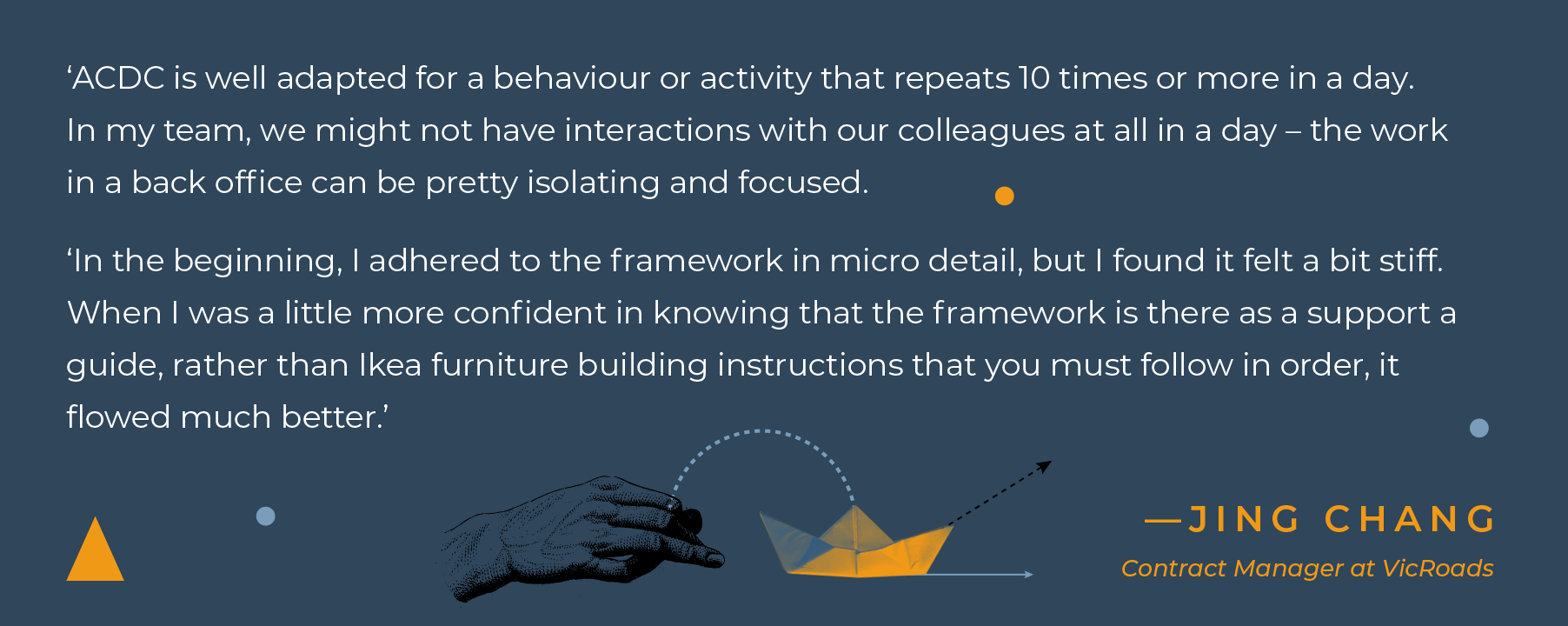Bringing back-office coaching front of mind
We recently caught up with Jing Chang, Head of the 4 person Concessions Deed Management team at VicRoads who has successfully used the GRIST ACDC Tactical Leadership model to drive behavioural change, enhance productivity, and foster team engagement in her new leadership role.
We explored how coaching could be applied to any team seeking to improve, change, or enhance performance, specifically back-office teams facing unique challenges.
Back-office teams often struggle to coach behaviourally, it's not something that comes naturally to teams that don't have a customer as a reference point. There are often multiple roles in these teams performing very different tasks.
So how do you navigate what to focus on and how to coach these sorts of teams?
Here’s what Jing did…
You’re working with a back-office team encompassing really varied roles, so how have you taken the approach of tactical coaching to micro-behaviours, and adapted that for a team that is so diverse in their day-to-day job?
It was a tough one - trying to identify a micro-behaviour that the entire team could implement, because it needed to relate to everyone’s roles, as well as something that we could do frequently. My team had to take a step back and we arrived at treating our internal colleagues in the business as the customer, in a sense, then, focused on our interactions with them as the opportunity.
The micro-behaviour we all chose was to let our colleagues know how the Concessions team can help them.
It was a broad enough micro-behaviour that people could adapt it to each role or interaction, but it was still small enough change that everyone felt that they could perform it at least a few times a week consistently.
Have you found you've had to adapt the ACDC model because of that shift?
ACDC is well adapted for the kind of behaviour or activity that you would repeat 10 times or more a day. In my team, we might not have interactions with our colleagues at all in a day - the work in a back office can be pretty isolating and focused. In the beginning, I adhered to the ACDC framework in micro detail, but I found that after the first few coaching sessions, it felt a bit stiff, because I was approaching it as a set of rules. When I was a little more confident in knowing that the framework is there as a support a guide, a reference for me, I was able to adapt it to each team member in each session.
That confidence building was great, because I know that it’s always there as a reference point to go back to, but also is a set of guiding principles, rather than Ikea furniture building instructions that you must follow in order.
There are micro-behaviours like ‘Practice’ that are easy to implement in a coaching session with a frontline staff member, but in your coaching sessions they might look quite different, right? (2-way role plays are the best practice execution of Practice)
Practice was certainly an interesting one. A lot of our interactions are via email or Teams messages, rather than face to face conversations. We landed on doing Practice both in team huddles, as well as the 1:1, especially at the beginning to get everyone familiar with the concept of micro-behaviours.
It was a more fun way of practising. We through a whiteboard marker to each other, and the person who caught it was the one who has a chance to practice and then throw it to the next person. It didn't feel too intimidating because everyone had a chance, it was quick, and it was just focusing on that little bit of practice, not the whole conversation. I volunteered myself first, but made sure we went around the team. We didn't focus on good or great, just on doing it. You can't improve or perfect something that you're not doing, you've got to do it first and do it consistently.
I liked that idea of practising as a group because you're getting a chance to do the practice, but you're seeing everybody else's practice and absorbing that learning as well. It’s especially beneficial for a team who doesn’t do repetitive tasks every day, to get that repetition.
It's teamwork. You collaborate and learn from each other. The VicRoads values are to Care, Share and Dare – and those values can be done in a team huddle. You hear your team members doing it, play off each other's ideas, borrow each other's ideas to get a sense of helping the whole team with that activity.
If you’d like to hear more from Jing about her transition in mindset from a manager of tasks to a manager of people, switching from telling to asking, getting over being awkward when self-assessing, and more, you can watch our full conversation here.


